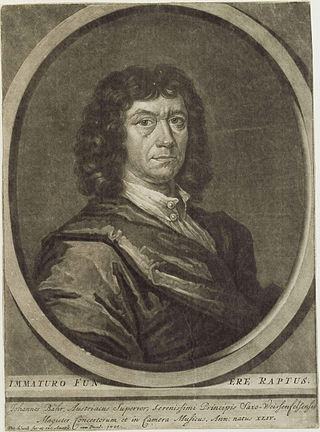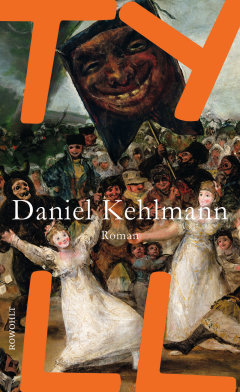
German literature comprises those literary texts written in the German language. This includes literature written in Germany, Austria, the German parts of Switzerland and Belgium, Liechtenstein, Luxembourg, South Tyrol in Italy and to a lesser extent works of the German diaspora. German literature of the modern period is mostly in Standard German, but there are some currents of literature influenced to a greater or lesser degree by dialects.
This article contains information about the literary events and publications of 1669.
This article contains information about the literary events and publications of 1668.

Gelnhausen is a town, and the capital of the Main-Kinzig-Kreis, in Hesse, Germany. It is located approximately 40 kilometers east of Frankfurt am Main, between the Vogelsberg mountains and the Spessart range at the river Kinzig. It is one of the eleven towns in the district. Gelnhausen has around 22,000 inhabitants.

Hans Jakob Christoffel von Grimmelshausen was a German author. He is best known for his 1669 picaresque novel Simplicius Simplicissimus and the accompanying Simplician Scriptures series.

Simplicissimus was a satirical German weekly magazine, headquartered in Munich, and founded by Albert Langen in April 1896. It was interrupted by a hiatus from 1944–1954, became a biweekly in 1964, and ceased publication in 1967. It took its name from the protagonist of Grimmelshausen's 1668 novel Der Abenteuerliche Simplicissimus Teutsch.

Mother Courage is a character from a Grimmelshausen novel Lebensbeschreibung der Ertzbetrügerin und Landstörtzerin Courasche dating from around 1670. The character had played a cameo role in Der abentheuerliche Simplicissimus in 1669.

Renchen is a small city in Baden-Württemberg, Germany, part of the district of Ortenau.

The Schwedentrunk is a method of torture and execution in which the victim is forced to swallow large amounts of foul liquid, such as excrement. The name was invented by German victims of Swedish troops during the Thirty Years' War. This method of torture was administered by other international troops, mercenaries, and marauders, and especially by civilians following the Swedish baggage train, who received no pay. It was used to force peasants or town citizens to hand over hidden money, food, animals, etc., or to rape women.

Denzlingen is a municipality in the district of Emmendingen, in Baden-Württemberg, Germany. It is situated 8 kilometres (5.0 mi) north of Freiburg.
Baldanders or Soon-Different is a creature of Germanic literary myth that features protean properties.
Camden House, Inc. was founded in 1979 by professors James Hardin and Gunther Holst with the purpose of publishing scholarly books in the field of German literature, Austrian Literature, and German language culture. Camden House books were published in Columbia, SC until 1998. When the company became an imprint in that year, place of publication moved to Rochester, NY.

The Moos is a mountain range in the Central Black Forest in southern Germany. Its highest points are the Siedigkopf and the Mooskopf, actually the Geisschleifkopf. The Moos is the local mountain or Hausberg of Gengenbach and Oppenau.

Johann Beer (also spelled Bähr, Baer, or Behr, Latinized as Ursus or Ursinus; was an Austrian author, court official and composer.
Grimmelshausen-Preis is a literary prize in Germany, which is awarded since 1993 on every two years. The prize is named after Hans Jakob Christoffel von Grimmelshausen, author of Simplicius Simplicissimus, a famous German book. The prize money is €10,000.

Philipp Moritz of Hanau-Münzenberg succeeded his father as Count of Hanau-Münzenberg in 1612.

Tyll is a 2017 novel, originally written in German, by the Austrian-German writer Daniel Kehlmann. The book is based, in part, on the folkloristic tales about Till Eulenspiegel, a jester who was the subject of a chapbook in 16th century Germany, as well as on the history of the Thirty Years' War. The book was first published in October 2017 in the original German by Rowohlt Verlag. An English translation by Ross Benjamin was published in the United States by Pantheon Books, a division of Penguin Random House, New York, in February 2020. Between its initial publication in 2017, and its publication in English, Tyll had sold almost 600,000 copies in Germany.
The Literaricum Lech is a literary conference in Lech am Arlberg in Vorarlberg (Austria). Its aim is to discuss classic as well as contemporary literature in a way that is accessible, innovative and diverting. It has premiered from 8 to 10 July 2021.
Herbert Karl Ludwig Kranz, pseudonym Peter Pflug was a German writer.













